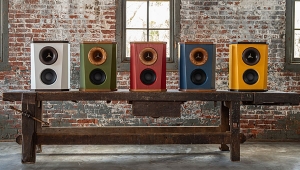| Columns Retired Columns & Blogs |
Paul Barton: It Doesn't Get Much Better Than That Page 4
Barton: Exactly. It must have been a strange configuration, as you don't often get off-axis peaks at high frequencies as much as you get a bad blend between the directivity of the larger driver crossing over to a much smaller driver.
Atkinson: The speaker that has been my favorite for a while, the B&W Silver Signature, is a two-way with an 8" woofer. So what you have is a little bit of off-axis flare at the bottom of the tweeter passband. But the woofer appears to be rolled off a little early to give a shallow depression in the on-axis response in exactly the same region where the power response has a little too much energy. So when you read about loudspeaker designers "voicing" their speakers, I think that what they're doing is playing around with the on-axis response to compensate for discontinuities in the dispersion.
Barton: Yes. I would definitely agree with that. Can I talk about other speakers? It's one that no longer exists, but the original KEF R104aB was very flat on-axis. But they crossed the tweeter over way too high. If you put a pair in a room that had reflections, it was a very laid-back speaker. Very distant-sounding. Very pleasant.
Atkinson: Because of the lack of presence-region energy in the room?
Barton: Because the total energy wasn't there. The 104 was a very well-respected loudspeaker, and quite frankly worked well in a dead-end/live-end situation, which was at that time the way KEF designed loudspeakers. But it was very room- and placement-sensitive.
Take a speaker that has smooth sound, power, good off-axis response, good on-axis response. When you think about it, it's probably the most forgiving speaker in any kind of environment. Because when the room is dead, all you hear is the on-axis sound, and it's okay! And when it's in a live room, you hear the sound power, or the reverberant energy, and that's okay!
Atkinson: A subject we haven't touched on yet is crossovers. Some people have this almost mystical belief in one kind of crossover vs another, whether it be first-order or fourth-order or whatever. Is that misguided?
Barton: Well, there are tradeoffs. On the Stratus Gold i and the other Stratus models, I use a fourth-order Linkwitz-Riley crossover between the tweeter and the driver it crosses over from. Now these filters I'm talking about are acoustic filters. If you opened up the speaker and counted the components in the topology, it wouldn't add up to a fourth-order Linkwitz-Riley. You have to look at the transfer function of the drivers as well as that of the electrical filters. I get a kick out of seeing schematics in articles written about different types of topology. It doesn't matter. The driver has its own natural rolloff. And if you take advantage of that, you can save components. You want the acoustic transfer function. You don't want the electrical one.
I use a third-order crossover between the woofer and the midrange driver. And of course, on the Stratus Gold, the drive-units are quite far apart. That's by virtue of the fact that at 250Hz, which is where the woofer crosses over to the midrange driver, the wavelengths are still fairly large. In terms of path length, they're still acoustically in a very similar place. However, the 6" midbass/midrange driver and the tweeter are as close together as they can be. At the 2.2kHz crossover frequency, a few inches make a difference.
Of course, the tweeter and the midrange driver in the Stratus Gold i are not coincident. So you run into a problem in the vertical plane: moving from a seated position to a higher or lower one will result in interference because the drivers aren't acoustically in the same place. A lot of people ask me why the Stratus Gold's midbass unit and tweeter are inverted, in that the tweeter is below the midrange. Take a Linkwitz-Riley crossover at 2.1 or 2.2kHz, and measure this loudspeaker with the tweeter on top, and look at the region where the drivers are acoustically in-phase so that they sum accordingly. The Linkwitz-Riley adds in phase and amplitude—the drive-units are in-phase and down 6dB at the crossover point, whereas a Butterworth is down 3dB. When you put all of those in the same pot and stir it up...
Atkinson: In front of the speaker it adds, and you get a smooth transition.
Barton: But just by virtue of the size of the drivers, the distance they are apart, and the crossover frequency, the interference between the drive-units means that [the main lobe] is actually tilted downward . . . The reason we put the tweeter below the midrange is that with that configuration with a Linkwitz-Riley crossover, the lobe tends to tilt up in the direction that people would be in from the seated to the standing position. In that respect, I like to think of the speaker as being somewhat social as opposed to anti-social.
- Log in or register to post comments




































